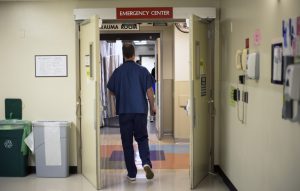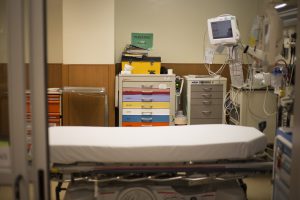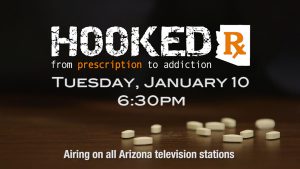Since 2010, nearly 67,000 people in Arizona have required emergency room care for opioid-related overdoses and illnesses, according to an analysis of hospital discharge data by the Arizona Department of Health Services. Those ER admissions increased from 7,753 in 2010 to 15,867 in 2015.
For ER physician Kara Geren of Maricopa Integrated Health System, the cycle of overdoses is part of a daily routine. Geren works in one of Phoenix’s inner-city neighborhoods off 26th and Roosevelt streets.
Yet the urban characteristics that once made her hospital and neighborhood prime targets for such a crisis no longer matter. The ease with which anyone can get prescription painkillers has made this issue transcend demographics, she said.
“As time has gone on, it is no longer an inner city vs. suburban problem,” Geren said. “It’s everybody’s problem. I’ve worked in multiple different emergency departments from inner city to suburban to rural and everyone has this problem. It does not discriminate against gender, age, income – this has hit everyone.”
Dr. Dan Quan works with Geren in the Phoenix emergency department as a medical toxicologist. Quan said addiction impacts every community, regardless of age or income.
“It affects everybody from somebody who is homeless, all the way to folks that are well-off and well-to-do,” he said. “It actually crosses all sorts of racial and financial lines that we typically used to see. Heroin users, maybe they would be more of the inner-city folks. Now, we’re seeing heroin use widespread, all across all patient populations.”
Geren said the problem isn’t unique to Arizona. Rather, it’s a national trend.
And the statistics support Geren’s assertion. Since 1999, the number of opioid prescription sales has quadrupled nationwide, according to the Centers for Disease Control and Prevention. The issue isn’t isolated to prescriptions, either. The prescriptions can sometimes serve as a starting point for harder, cheaper drugs like heroin.
“We are 5 percent of the population in the U.S. of the world population, and we use 80 percent of the prescription drugs – opiate prescription drugs,” she said. “So they say that 75 percent of heroin users start by experiencing an opioid prescription. And it just kind of snowballs from there.”
Some areas appear to have been impacted more adversely than others. According to the data reviewed by Cronkite News, some hospitals and ZIP codes have seen dramatic spikes in emergency department overdoses.
The Banner Desert Medical Center in Mesa, off Southern Avenue and Dobson Road, rests in the heart of the struggling Fiesta District. What was once a shopping destination for the Phoenix suburb has become a community in crisis for the opioid epidemic.
The DHS numbers show about 206 ER overdoses alone through 2015, up from 158 in 2014. Mesa’s hospital only provides a glimpse into the statewide epidemic. Ten hospitals in the state from Phoenix to Tucson, Glendale to Mesa, have had to bear the brunt of the epidemic.
Just as opioid prescription sales have quadrupled since 1999, deaths from opioid overdoses also have quadrupled, according to the CDC. From 1999 to 2014, more than 165,000 people died from opioid overdoses nationally – 14,000 in 2014 alone.
But whether or not the opioid “epidemic,” as doctors call it, can be fixed is immaterial once users make it to hospitals. They say inpatient and outpatient care staff are more focused on simply keeping up with the influx of patients.
“I wouldn’t say that we’re struggling to keep up with the problem, but an emergency department is a very unique environment in that we have to deal with anything that happens – regardless,” Geren said. “We’re able to keep pace, but once we treat patients in the emergency department, where do they go? Treatment centers aren’t able to keep pace. And physicians that are trying to treat chronic pain problems with alternate methods aren’t able to keep pace.”
The escalating addiction problem, Quan said, is something emergency department staff not only have to prepare for; they also have to be ready to take extreme measures to bring addicts back from the brink of death.
An overdose happens when breathing stops and addicts essentially suffocate themselves, he said.
“We use something called a bag-valve mask – and that’s a mask with a balloon that we (use to) push air into their lungs – versus a tube that we put down into their lungs and their trachea to help them breathe and put them on a ventilator,” he said. “That would be the ultimate way to save someone’s life. And, of course, there’s the naloxone, the opiate-reversing agent that we would use to give to patients in that situation.”
Eric Downing has lived in Phoenix since he was 5 years old. Although he said he’s been sober since August 2014, his addiction has included multiple overdoses.
“There was one time in particular where I took a lot of of muscle relaxers and quite a bit of morphine,” Downing said. “And I wound up calling one of my friends, and he was like, ‘Hey let’s go to the lake.’ So we went to the lake, and on the way there, all of the pills started kicking in at once.”
As the drugs overpowered him, Downing would move in and out of consciousness.
“I remember blacking out and coming back to, and she’s pulling my arm … then I remember just passing out, I finally come back to and there’s an ambulance,” he said. “They load me into the ambulance, they pump me full of Narcan, and they take me to the hospital. And while I’m there, I black out again, and I come back to and the nurse says, ‘Do you remember not breathing for four minutes?’”
Downing said he adopted a longing for death. All he had to live for were the highs he chased.
“I remember just crying uncontrollably,” he said. “And again, up until this point, I thought that I wanted to die. I thought that I was so miserable, that there was no way out, that I wanted to die. But at that moment, when she told me that I almost did, and by my reaction of me crying, I knew that I wanted to live, and that scared the heck out of me.”
Because the effects and pain of withdrawals, something addicts call “dope sick,” are so powerful, most choose to medicate with more drugs.
“The withdrawal is probably why you have a lot of people in this epidemic, because they don’t want to go through that uncomfortable withdrawal,” Quan said. “So you have to seek out other forms of opiates, whether it’s methadone, oxycodone, Percocet, to heroin to help the symptoms. So you don’t withdraw.”
That, experts say, is why the rampant prescribing and use of opiates is so difficult to stop.
“It used to be that when a patient came in with an altered mental status, it’s something that we would consider on the differential diagnosis as something that maybe is causing the patient’s condition,” Geren said. “But now, it seems like it’s much more likely (it’s an overdose) and it’s something that we definitely have to consider and, oftentimes, treat.”
To properly address the epidemic, prescribers need to critically reevaluate the way they assign medications, Geren said. Without that, no real progress can be made.
“Since this has become an issue, I can say that I personally have changed my prescribing habits and I know a lot of other providers have, as well,” she said. “It has to start from the ground up, but I think it’s not just physicians – I think it’s everyone. I think it’s just the way parents talk with children about alcohol, this is just one of the other drugs that people have to consider and one of the other things that the community has to think about how they’re going to attack.”
Quan said prescribers such as himself and Geren are now being monitored more closely by government regulators to make sure they are maintaining safe prescribing habits.
“As a prescriber, I’m under more scrutiny on how many opiates I write, how many benzos and the various medicines that I write,” he said. “We’re being watched very carefully. And those prescribers who are running pill mills, as they call them, are being watched very, very carefully and being prosecuted, as well.”
Kayla McBride’s addiction started with prescription pills until she turned to heroin. Last year, she was living in a Prescott sober living house, though she said she since has relapsed at least once. She has overdosed five times.
“I was really sick one time, and I couldn’t find anything. And I took a whole bottle of Ambien,” McBride said. “I guess I died for about two minutes. Don’t remember that either.”
McBride woke up in the hospital the next day and had a single thought:
“I need to get high.”
^__=




